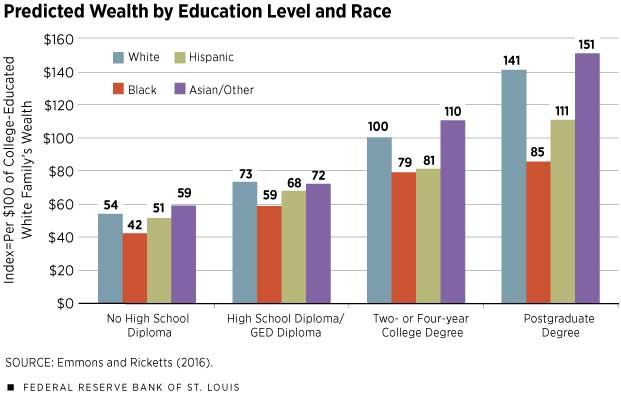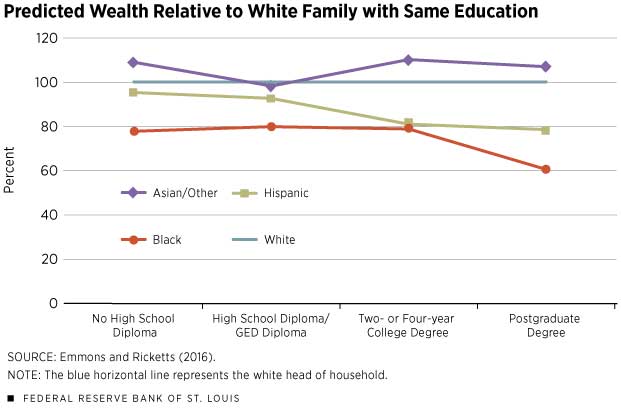Unequal Degrees of Affluence: Racial and Ethnic Wealth Differences across Education Levels
Family wealth generally increases with education.1 This is true within every major racial and ethnic group in the U.S. However, there are two important respects in which education’s association with wealth differs systematically by race and ethnicity.
First, at every level of educational attainment, the wealth effects of education for Hispanics and African-Americans are lower than they are for non-Hispanic whites and Asians.
Second, Hispanics and blacks see smaller increases in wealth than do whites and Asians when moving to a higher level of education.
We illustrate these differences briefly, then describe the results of an econometric model of wealth accumulation that suggests which underlying mechanisms may be at work—and some that are not.2 In particular, we found that differences in a group’s average education level, differences in family structure, and differences in income shocks or inheritances are not responsible for vastly different wealth outcomes. Instead, deeply rooted factors unique to the Hispanic and African-American experiences may be at work.
It is important to note that we discuss wealth (assets minus liabilities) and not income in this article. We study wealth because it is a broad measure of well-being, summarizing both the job-market outcomes of a family (income from work) as well as the financial decisions they make (saving and investing).
For an explanation of how races are defined, see short sidebar.
Details of Findings
Despite gains in expected wealth, every level of education translates into a lower relative level of wealth for black and Hispanic families. Figure 1 shows predicted wealth by race and ethnicity relative to a college-educated white family. Increasing levels of educational attainment uniformly yield higher expected wealth. However, at each level, black and Hispanic wealth is lower than white and Asian wealth.
Higher levels of education generally are associated with smaller (shallower) increases in wealth for Hispanic and black families. The second pattern, evident in Figure 2, is that the higher the education level of the family head, the larger the wealth gap typically faced by Hispanics and blacks, in percentage terms; the reverse is true for Asians. In other words, comparing one education level to the next higher one generally is associated with a smaller proportional increment to family wealth for Hispanic and black families than for white or Asian families.
Adjustments were made for a handful of observable differences in behaviors and circumstances to estimate wealth effects. Using a data set of more than 34,000 families that participated in the Federal Reserve Board’s Survey of Consumer Finances since 1995, we studied wealth accumulation with a particular focus on race and ethnicity.
We took into account:
- differences in each family head’s age and birth year, and the family structure (marital status, number of children, total number of family members, provision of financial support to extended family);
- education of the family’s head;
- financial behavior (detailed list of assets and liabilities, composite index of short-term financial-management skills);
- measures of luck or chance (income windfalls or shortfalls, receipt of an inheritance, health status); and
- the year in which the family participated in the survey.
The resulting model was very successful in accounting for differences in wealth accumulation across families, attributing most of the variation to the observable behaviors and circumstances noted above. One unexplained result was lower predicted wealth for black families even when holding constant all of the observable behaviors and circumstances.
Our model allowed us to answer the following hypothetical question: Compared with other families of the same age, birth year, marital status, family size, etc., corresponding to our full set of control variables, how much wealth would we expect a particular family to have based solely on its education level and its race or ethnicity? For purposes of comparison, we chose as our reference family a white family in which the family head holds no more than a two- or four-year college degree. The predicted wealth of all other education and race or ethnicity combinations is expressed relative to each $100 of the reference family’s wealth. If the links between education and wealth were the same for all races and ethnicities, we would predict equal wealth for all families with a given education level, regardless of race or ethnicity.
Figure 1 displays the results. Our expectation that better-educated families will have more predicted wealth is confirmed by the upward-sloping pattern of predicted wealth from left to right. For example, among four white families that differ only in their level of education, we expect the family headed by someone without a high school diploma to have $54 of wealth for every $100 of wealth held by the white college graduate family; the white high school graduate family to have $73 of wealth; and the white family with postgraduate education to have $141. The results for Asian families are similar.
We confirmed the finding noted above that black and Hispanic families typically have less wealth than their white counterparts at every education level. Asian families have less wealth than their white counterparts only at the high school education level and only by a slight amount; in all other levels of educational attainment, Asian families have higher wealth than their white counterparts.
A striking feature of Figure 1 is the progressively larger predicted wealth gaps for Hispanic and black families as we compare successively higher education levels. For example, the predicted shortfalls among Hispanic and black high school graduates are only $5 and $14, respectively, compared with the totals for whites; the shortfalls increase to $19 and $21 for two- or four-year college graduates, and to $30 and $56 among postgraduate families, respectively. We term this a shallow wealth effect from increasing levels of education.
Figure 2 quantifies the relationship we found between education level and predicted wealth for each racial and ethnic group. Asian and white families’ results look similar only for high school graduates, before and after which Asian wealth exceeds white wealth. Hispanic and black families, on the other hand, trace out a declining wealth payoff to education—or, equivalently, an increasing wealth gap at progressively higher education levels compared with white and Asian families.
Why doesn’t education translate into wealth at the same rate for all racial and ethnic groups? Our model is better-suited to identifying what is not responsible for the education-related racial and ethnic wealth gaps than what is responsible. We concluded that some commonly suggested reasons why Hispanic and black families usually have lower wealth than white or Asian families are not supported by our model. In particular, differences in average education level, differences in family structure, or differences in income shocks or inheritances are related to, but not particularly important determinants of, racial and ethnic wealth gaps. Even when we compare families of different races and ethnicities that are similar along these dimensions, which is the purpose of the econometric model, the wealth gaps remain.
This research instead points to deeper causes: structural, systemic or historical factors related to race or ethnicity that affect educational and/or wealth outcomes. For example, we classify all family heads with a two- or four-year college degree as having the same amount of education. We know, however, that there are differences across race and ethnicity in college and choice of majors. Current and historic discrimination affects access to and the quality of education. The likelihood and amount of borrowing to attend college differ by race and ethnicity, and the burden of repayment, therefore, also differs. Employment and advancement options may differ by race or ethnicity. Cultural norms related to homeownership, borrowing and other financial decisions could differ, also.
The bottom line is that, while more education is associated with more wealth among all races and ethnicities, the links are different. For reasons we do not fully understand, the typical wealth effects of education appear to be lower and shallower for Hispanics and blacks.
Endnotes
- See Emmons and Noeth (2015). [back to text]
- See Emmons and Ricketts (2016). We use the Federal Reserve Board’s Survey of Consumer Finances, which contains extensive demographic and financial information for more than 34,000 families observed once between 1995 and 2013. Survey respondents may identify with more than one race or ethnicity; we classify families by their first response. The category we call Asian also includes Native Americans, Pacific Islanders and other small groups not included elsewhere. See sidebar for more information regarding race and ethnicity. [back to text]
References
Emmons, William R.; and Noeth, Bryan J. The Demographics of Wealth, Federal Reserve Bank of St. Louis, 2015. See www.stlouisfed.org/household-financial-stability/the-demographics-of-wealth.
Emmons, William R.; and Ricketts, Lowell R. “College is Not Enough: Higher Education Does Not Eliminate Racial and Ethnic Wealth Gaps,” working paper, Federal Reserve Bank of St. Louis, 2016. See www.stlouisfed.org/~/media/Files/PDFs/HFS/20160525/papers/Emmons-Ricketts-paper.pdf.
Views expressed in Regional Economist are not necessarily those of the St. Louis Fed or Federal Reserve System.
For the latest insights from our economists and other St. Louis Fed experts, visit On the Economy and subscribe.
Email Us





